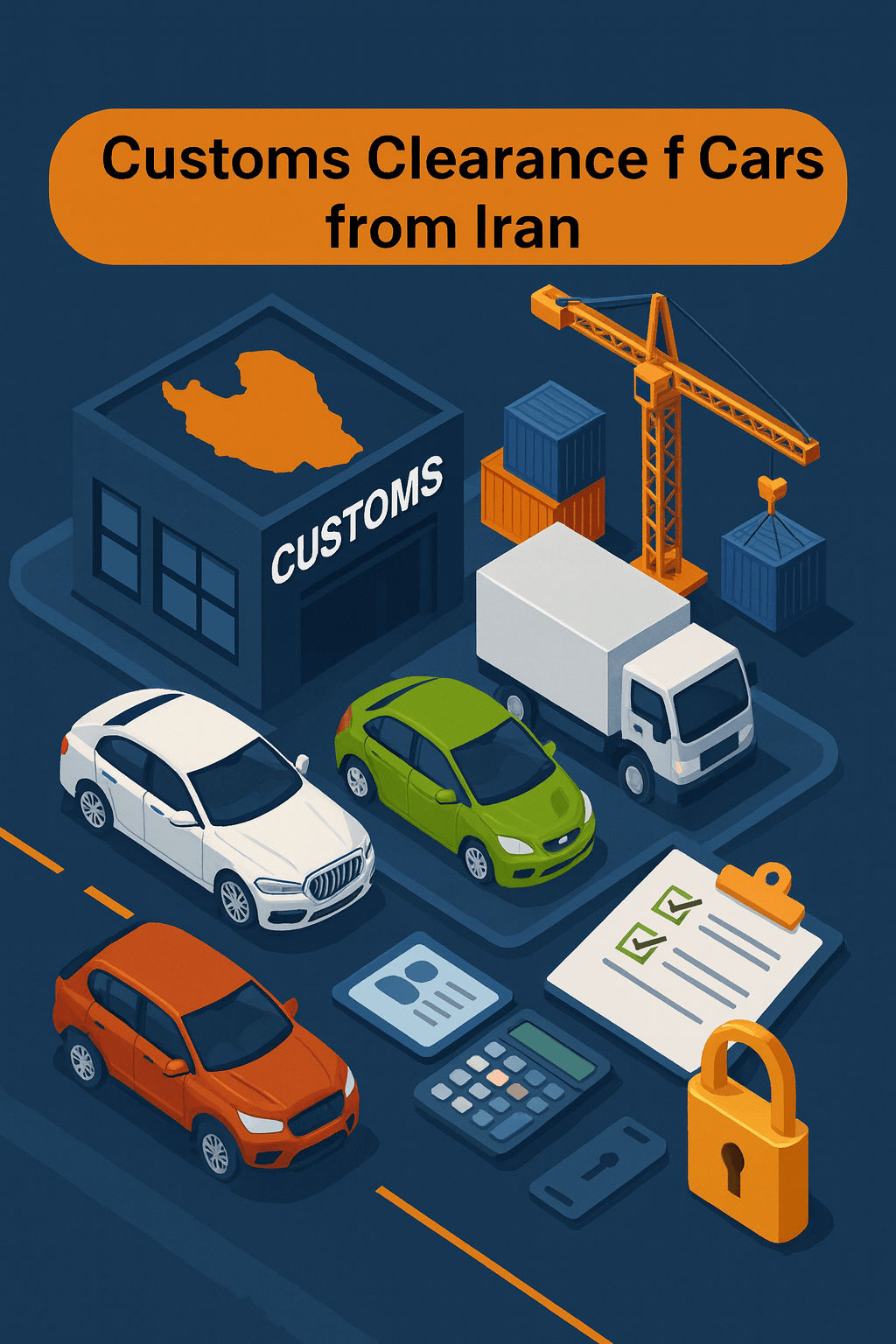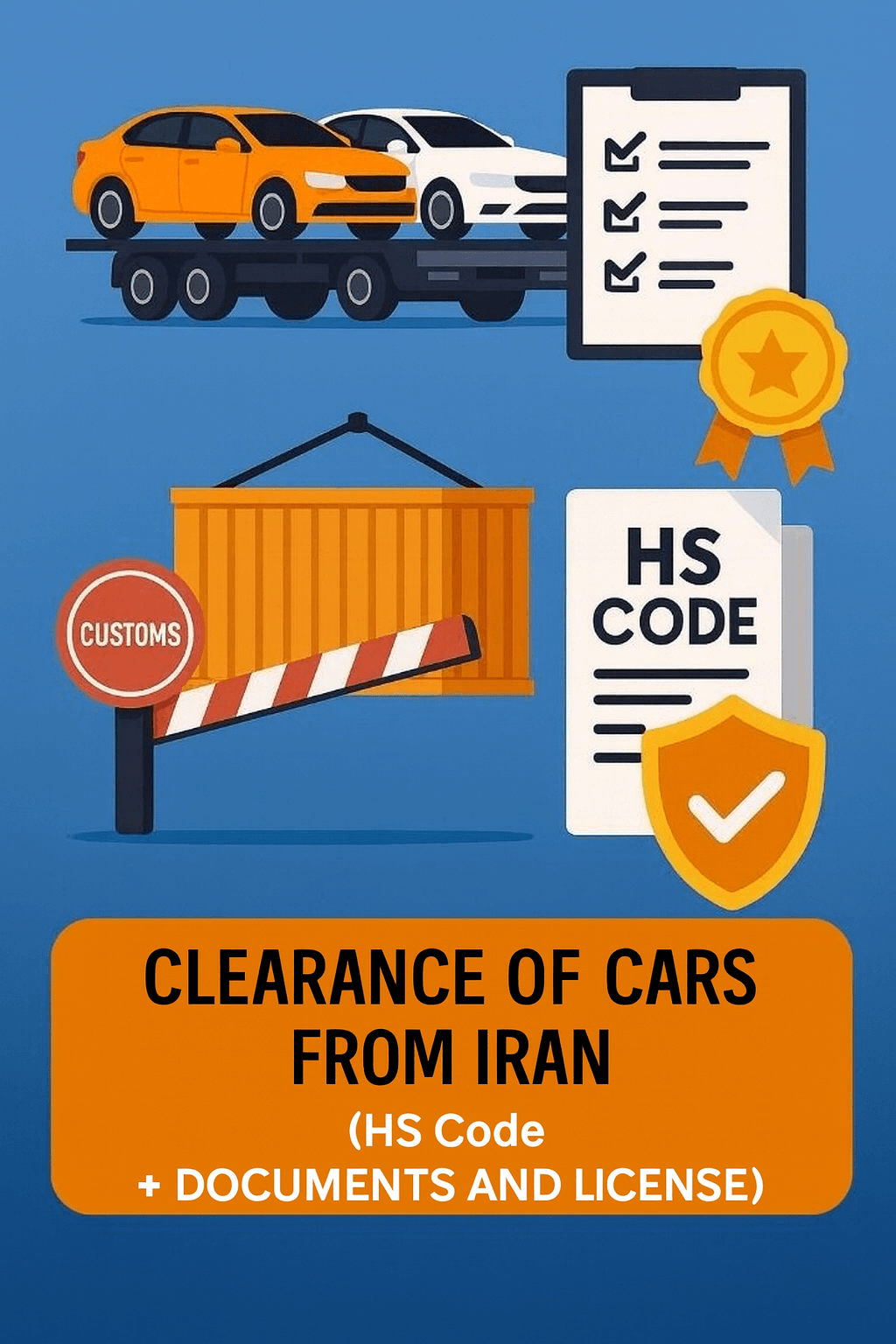Clearance of All Vehicle Types from Iranian Customs (HS Code + Documents & Permits)
Car customs clearance is one of the most sensitive and complex stages of importing goods into Iran. Because trade policies, tariffs, and standards change frequently, this process requires deep technical knowledge of customs and import regulations.
For time and cost estimates of car customs clearance, contact the Saba Tarkhis team.
Free & Instant Consultation
1) Detailed Overview: Imported Vehicle Types & Their Role in Clearance
Vehicles imported into Iran are grouped by type and use, each with its own requirements, standards, and tariffs. Knowing these categories is the first step to clearing cars through customs without time or cost overruns.
- Passenger cars: For personal and family use. Engine size, fuel type, and safety/environmental features affect tariffs and permits.
- Commercial vehicles: Trucks, buses, tractors, etc.; subject to stricter safety/environmental standards and rules tied to axle weight and use-case.
- Hybrid & electric: Growing urban demand; sometimes subject to incentives, but permits and standards must be reviewed carefully.
- Luxury vehicles: Due to high value and advanced tech, typically face restrictions, higher tariffs, and special requirements.
Uses in Iran span from private transport to freight and municipal fleets—this variety increases clearance complexity.
2) Types & Uses of Imported Vehicles in Iran
Passenger cars: The largest share of imports; ideal for personal/family, urban/intercity travel; highly popular in large cities for easy mobility.
Commercial vehicles: Vital to the national supply chain; trucks and buses for freight and passengers supporting industry and infrastructure projects.
Hybrid & electric: With rising fuel costs and environmental concerns, they’re economical and lower-emission—especially relevant for polluted cities.
Luxury: A niche market with special rules; typically for high-income customers and with more sensitive clearance processes.
3) Key Steps in Car Customs Clearance
Car clearance is sensitive and complex, requiring accurate knowledge of multiple national and international standards and regulations. Below are the main stages—each needs careful attention to avoid issues later.1. Conformity with national standards
Ensure compliance with technical, safety, and environmental requirements set by the Iran National Standards Organization.
Technical standards: Performance, parts quality, and system efficiency (brakes, suspension, electronics), aligned with global/ISO rules.
Safety standards: Body structure, airbags, ABS, ESP, etc., to protect occupants in accidents.
Environmental standards: Limits on CO₂/NOx/PM, fuel consumption, and fuel type. Hybrids/EVs face specific, often stricter criteria.
2. Determining customs value
Based on invoice price, comparable transactions, and international reference rates.
Invoice: Must clearly show purchase price and related costs (freight, insurance, etc.).
Comparable deals: Customs compares with similar models/years/specs globally.
Reference rates: International references (e.g., WTO/customs unions) help validate declared value.
3. Calculating & paying duties/taxes
Tariffs depend on vehicle type, engine displacement, fuel type, and other specs.
Type: Passenger/commercial/hybrid/EV each follow different tariff regimes; luxury/high-displacement often pay more.
Engine size: Smaller engines generally face lower duties to encourage efficiency.
Fuel type: Gasoline/diesel/hybrid/EV rates differ; hybrids/EVs may receive incentives.
Also consider VAT, registration fees, and customs service charges.
4. Securing required permits
Ministry of Industry, Mine & Trade (IMT): Import order registration/approval with invoice, specs, and contracts.
Department of Environment: Proof the vehicle meets emissions standards.
Traffic Police (Rahvar): Registration/number plate authorization after safety/traffic compliance checks.
5. Inspection & quality control
Pre-release checks for mechanical, electronic, and environmental compliance by customs or accredited inspection firms.
4) Customs Tariff & HS Codes
| Category | Short Description | HS Code |
|---|---|---|
| Passenger vehicles | Transport of people (gasoline/diesel/hybrid/EV) | 8703 (incl. some 8703.90 lines) |
| Commercial vehicles | Trucks, pickups, tractors, etc. | 8704 |
Exact subheading depends on engine size, fuel, axle/weight, safety/emission equipment, and year of manufacture.
5) Special Conditions for Importing Cars into Iran
- Imports are shaped by government policy and market conditions.
Import quotas: To control the domestic market and protect local makers—typically tighter for luxury models.
Strict rules for luxury cars: Higher tariffs, tighter limits, and special standards/permits from the IMT Ministry.
Environmental & technical standards: Compliance with Euro 5/6 equivalents is required; non-compliant vehicles cannot enter the market.
Sanctions and constraints: Financial/payment hurdles, parts access limits, and overall lower import volumes.
6) Iran Market: Exporting Countries to Iran & Iran’s Export Destinations
7) Trade Volumes: Iran’s Imports/Exports + Global Turnover
8) Global Market: Major Exporters & Importers
- Top exporters: Japan, Germany, South Korea, China, United States (over half of global exports).
- Top importers: United States, China, Germany, India, Japan.
9) Required Documents for Car Customs Clearance
- Clearance requires a complete set of documents; missing items cause delays or legal issues.
1. Proforma Invoice: Price, payment terms, specs — basis for customs valuation.
2. Commercial Invoice: Final pricing and delivery terms — main pricing document for duty calculation.
3. Bill of Lading: Carrier-issued transport document and title in transit.
4. Certificate of Origin: Issued by a competent body identifying manufacturing country; affects tariff preferences.
5. Import Order Registration (IMT): Official approval to import.
6. Standards Certificate: Conformity with national/international standards (often by INSO).
7. Environmental Certificate: Emissions compliance (Department of Environment).
8. Trade Card: Importer’s business card (Chamber of Commerce).
9. Additional Permits: Depending on type (IMT, Environment, Traffic Police).
10. Transport Insurance Policy: Coverage against in-transit risks.
11. Proof of Duties/Taxes Paid: Receipt for all customs payments.
12. Release Certificate: Customs’ final release authorization.
Key Tips & Practical Advice
- Car clearance involves multiple standards and permits. Focus on:
1) National standards review (technical/safety/environmental);
2) Accurate customs valuation;
3) Correct HS classification & duties;
4) Early permits coordination;
5) Pre-release inspections.
| Vehicle Type | Cost Drivers | Risk Points |
|---|---|---|
| Passenger (8703) | Engine size, fuel type, model year | Emissions standard, document authenticity |
| Commercial (8704) | Axle weight, axle count, application | Safety, weighbridge mass, special permits |
| EV/Hybrid | Battery/powertrain, safety equipment | Special permits, charging infrastructure |
| Luxury | High value, special options | Import caps/limits, heavy tariffs |

FAQs
Which HS Codes are common for imported cars?
Passenger vehicles: 8703 (including some 8703.90 lines); commercial vehicles: 8704. Final subheading depends on engine size/fuel/weight/equipment.
What documents are required for car clearance?
Proforma, commercial invoice, B/L, CO, import order registration, standards & environmental certificates, trade card, additional permits, cargo insurance, proof of duties/taxes paid, and release certificate.
What are the main clearance costs?
Import duty based on type/engine/fuel, VAT, customs service fees, inspection, and registration. Luxury/EV/hybrid may have extra requirements.
How can we shorten the clearance time?
Pre-submit documents for review, set the correct HS code, coordinate early with permitting bodies, choose well-equipped customs offices, and use experienced teams.
Specialized Car Clearance by Saba
End-to-end expert consulting: From model selection to permits and duty payments.
Faster processing: Administrative steps handled with speed and accuracy; close coordination with customs and related bodies to minimize delays.
Permit acquisition: We obtain all required approvals quickly, saving you time and effort.
Quality inspections: With accredited inspection firms to ensure compliance with national and international standards.
Training & advisory: Optional training so importers understand legal and financial aspects throughout.
With our services, all import stages are handled swiftly and precisely, removing complexity from customs and permitting.
Contact us now for more information and specialized consulting.
.png)
